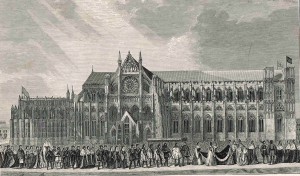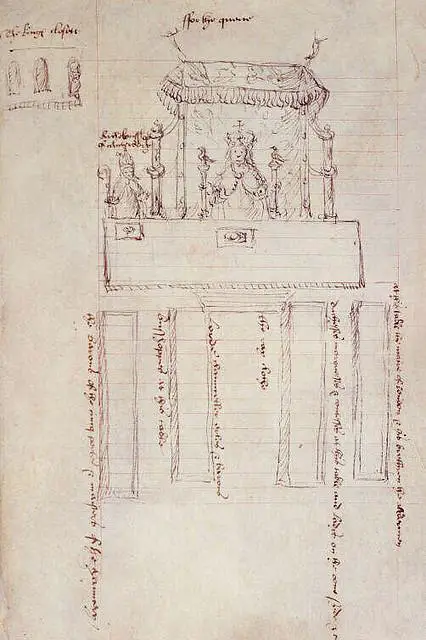
Henry VIII and Anne Boleyn had waited six years for this day and they must have felt real triumph and joy. Anne was queen and she was pregnant, all was good with the world.
The day started with the Mayor of London, aldermen, sheriffs and Council of the City of London taking a barge to Westminster at 7am and waiting there for the queen. Anne Boleyn arrived somewhere between 8 and 9am and stood under the cloth of state as the royal court and peers gathered. Once everybody was ready, the officers of arms organised everyone into a procession to make their way on a railed blue “ray cloth” which had been laid from the high dais of the King’s bench in the hall all the way to the high altar of the abbey – a 700 yard route. Chronicler Edward Hall records the order of the procession as:
- Gentleman
- Squires
- Knights
- Alderman of the City
- Judges
- Knights of the Bath
- Barons and viscounts
- Earls, marquesses and dukes
- Lord Chancellor
- Staff of the Chapel Royal and monks
- Abbots and bishops
- Sergeants and officers of arms
- The Mayor of London
- Marquess of Dorset, bearing the sceptre of gold
- Earl of Arundel, bearing the rod of ivory topped with a dove
- Earl of Oxford, High Chamberlain of England, carrying the crown of St Edward
- Charles Brandon, Duke of Suffolk and High Steward of England for the day
- William Howard, carrying the rod of the Marshal of England
- The Garter Knights
- The Queen
Anne was dressed in ermine-trimmed purple velvet coronation robes, and had a coif and gold coronet on her head, the same coronet she’d worn for the procession the previous day. She walked barefoot under a canopy of cloth of gold carried by the barons of the Cinque Ports and her train was borne by the Dowager Duchess of Norfolk. As she processed behind the sceptre of gold, the dove-topped rod of ivory and the Lord Great Chamberlain (the Earl of Oxford), who bore the crown of St Edward, she was followed by the bishops of London and Winchester, ladies and gentlewomen all dressed in scarlet, and her train was carried by the Dowager Duchess of Norfolk. This procession was watched secretly by the King, who hid behind a lattice screen in a special stand.
When she reached the gold-draped chair of St Edward, Anne sat and rested for a few moments before making her way to the high altar and prostrating herself (not an easy thing to do when you’re pregnant) for Archbishop Cranmer to pray over her. Anne then got up and Cranmer anointed her. She was then able to rest again in St Edward’s chair while orations were said. Cranmer then crowned her with the crown of St Edward, a crown usually reserved for crowning the reigning monarch, and placed the sceptre in her right hand and the rod in her left hand. The Te Deum was sung and Cranmer helped Anne exchange the heavy crown for a custom-made lighter version.
After the Mass, Anne took the Sacrament and then gave the traditional offering in St Edward’s Shrine. The service was now over, and Anne was able to get some fresh air and refreshment before processing back into Westminster Hall, via New Palace Yard with its cisterns running with wine.
Then it was time for everyone to get back in line to process to Westminster Hall for the traditional coronation banquet. As she walked to the sound of trumpets, Anne’s right hand was “sustained” by her father, Thomas Boleyn, Earl of Wiltshire, and her left hand by Lord Talbot, acting on behalf of his father, Earl of Shrewsbury.
At the banquet, Anne sat on the King’s marble chair set under a cloth of state. She sat next to Thomas Cranmer, Archbishop of Canterbury, and was attended by the Dowager Countess of Oxford and the Countess of Worcester, who stood beside her, and two gentlewomen at her feet. The Earl of Oxford was High Chamberlain, the Earl of Essex was the Carver, the Earl of Sussex the Sewer, the Earl of Derby the Cupbearer, the Earl of Arundel the Chief Butler and Thomas Wyatt the chief Ewer, on behalf of his father. Between Anne and the Archbishop stood the Earl of Oxford, with his white staff of office. When everyone was seated, the Duke of Suffolk and William Howard entered the hall on horseback to announce the first course, which was being carried by the Knights of the Bath. Suffolk is described by Hall as wearing a jacket and doublet “set with orient perle” and a gown of embroidered crimson velvet, sitting on a horse draped with crimson velvet, embroidered with real gold letters, which reached the ground. “Trumpets and hautbois sounded at each course, and heralds cried “largesse.”” Henry VIII did not join the banquet, but watched the proceedings accompanied by the ambassador of France and Venice, from a special “little closet”.

After around eighty dishes, the banquet ended with wafers and hippocras, then the Queen washed and enjoyed “a voyde of spice and comfettes”. Then, the Mayor of London gave Anne a gold cup, from which she drank before giving it back to him. Anne then retired to her chambers where she had to go through the formalities of thanking everyone before she could rest. It finished at around 6pm. She must have been exhausted being heavily pregnant and having such a long day.
Notes and Sources
- The noble tryumphaunt coronacyon of Quene Anne, wyfe unto the most noble kynge Henry VIII, printed by Wynkyn de Worde, 1533.
- Hall, Edward. Hall’s Chronicle, collated editions of 1548 and 1550.
- LP vi. 583, 584 and 585.
- Ives, Eric. The Life and Death of Anne Boleyn, p178-183.
- Pictures: The coronation procession of Anne Boleyn to Westminster Abbey (from a drawing by David Roberts in the Tyrell Collection), illustration from The History of Protestantism by James Aitken Wylie (1808-1890), published 1878; Seating plan for the coronation banquet of Anne Boleyn, BL. Harley MS. 41. fol. 12.